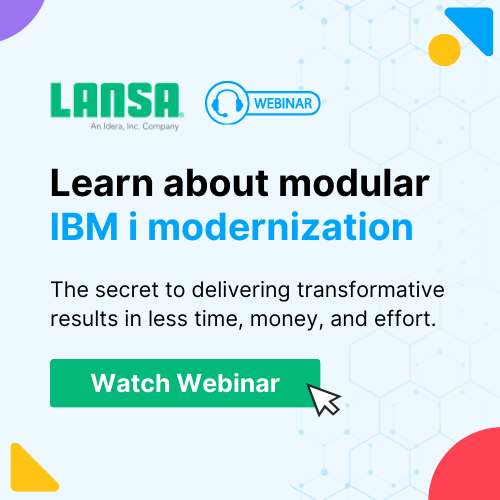Despite the fact that IBM i software is quite popular now and it performs its functions well, it can be still significantly outdated. Therefore, the task of IBM application modernization is very important and urgent. In this article, we will look at which characteristics of IBM i software should be upgraded and which tools will help you with this.
What Is IBM i Software?
IBM i is an integrated operation system developed by IBM for the AS/400 line of systems. The IBM AS/400 (Application System) is a line of mid-range computers released by IBM in 1988. It has a high level of performance and lower cost compared to its predecessors, so it has become very popular.
IBM i is the only operation system supported by the original AS/400 hardware. A lot of AS/400’s most advanced features were implemented in this OS instead of the underlying hardware. For example, multi-user support, RDBMS database (Db2), menu-based interface, printers, etc.
The AS/400 platform supports single-tier storage virtual memory. This means that you can access RAM and disk as a single address given by 64-bit address space. AS/400 and its operation system have an object-oriented design where everything is an object with built-in persistence and garbage collection.
What Is IBM i Used For?
IBM i is a flexible operation system that has a stable organization. Because of this, it is often used for ERP and other critical tasks. This is especially important for data-intensive industries such as manufacturing. However, you can use IBM i for any other task. The IBM i deployment method depends on your use cases. Depending on your goals, you can use hybrid cloud solutions, and mobile or web applications.
Why Should You Modernize IBM i Software?
Most IBM i software components have become significantly outdated over the past decades, so they could be modernized. When existing applications don’t meet the business goal, it is impossible to integrate them with new applications, support for legacy applications is too expensive, then it’s time to upgrade. Modernization gives you the ability to update legacy applications with modern technology and continue to use them.
Top reasons to upgrade IBM i software:
- Allows you to create new user interfaces, for example, for browsers and mobile devices.
- Allows you to improve the quality of the software.
- Reduces costs and simplifies the maintenance process.
- Adapts a legacy application to support the new business model.
- Facilitates access to information for staff and customers.
Learn more about how your business can fulfill an agile target architecture in this article about IBM Insurance Application Architecture.
Which Characteristics Of IBM i Software Should You Modernize?
The characteristics of an application are what you see: the source code, the business logic, the data access processing, the database, and/or other data sources. Modernization can occur across a whole application or at a characteristic level, such as the data access and database level, depending on the requirement of the business. A common understanding of the architecture of an application consists of three layers: Presentation Layer, Business Layer, and Data Layer.
What is the Presentation Layer?
The presentation layer is the user interface that you see when using the application. Legacy applications usually look and work differently than modern ones. Therefore, they are often inconvenient to use and require modernization at the presentation layer.
Modernizing the presentation layer requires replacing the green screen terminal display with a graphical display that is generated by a computer, mobile device, or browser. No changes are required in the application logic.
AXes from LANSA is a unique tool that allows you to convert legacy 5250 applications into web pages. It does not require programming skills and access to the code.
You can use the LongRange tool to build modern mobile apps. It makes it easy to create stylish, fast, and secure solutions for mobile devices with a simple builder.
What is the Business Layer?
At the business layer, the application implements algorithms, computational logic, data validation, and business rules. In a legacy application, rule maintenance occurs within the application itself. In contrast, in modern software, business rules are separated into separate services or mechanisms. Thus, they become available to other applications and are no longer blocked within the application.
Creating web services from legacy application functions allows other applications to use the business processes available in legacy applications. Restructuring the business layer helps to separate the presentation layer and data layer of the legacy application.
LANSA RAMP is a tool that allows you to create applications from scratch while using the logic of existing legacy applications in them and adding new features. It delivers a new system without starting from scratch. RAMP allows you to reuse the best parts of your current systems. By combining existing functionality with new features in the RAMP application environment, you get the applications you need without throwing everything away. Modernization is performed in stages, new features can be introduced gradually without a serious impact on business operations.
If you need a fast and easy way to remotely check and process data, then you can use the low-code Visual LANSA platform. It allows you to quickly create, deploy, and run the program on any device.
What is the Data Layer?
At this level, the database and data access mechanisms are managed. In legacy applications, the process of accessing data is mixed with business rules. In modern systems, the database is separated from the application and a new data access mechanism is created.
To separate data from business logic, you need to create separate modules or subroutines for accessing data. Modernization at this level makes data more accessible to other applications.
To modernize the data layer, you can use the RAMP tool described above, which makes it easy to add data access logic to a new modern application.
Ready to get started modernizing your IBM i software?
Install a free trial version of LANSA and try to use the tools it provides to modernize all levels of your IBM i application.








0 Comments